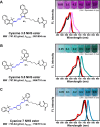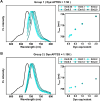Advancing fluorescence imaging: enhanced control of cyanine dye-doped silica nanoparticles
- PMID: 38898529
- PMCID: PMC11188253
- DOI: 10.1186/s12951-024-02638-7
Advancing fluorescence imaging: enhanced control of cyanine dye-doped silica nanoparticles
Abstract
Background: Silica nanoparticles (SNPs) have immense potential in biomedical research, particularly in drug delivery and imaging applications, owing to their stability and minimal interactions with biological entities such as tissues or cells.
Results: With synthesized and characterized cyanine-dye-doped fluorescent SNPs (CSNPs) using cyanine 3.5, 5.5, and 7 (Cy3.5, Cy5.5, and Cy7). Through systematic analysis, we discerned variations in the surface charge and fluorescence properties of the nanoparticles contingent on the encapsulated dye-(3-aminopropyl)triethoxysilane conjugate, while their size and shape remained constant. The fluorescence emission spectra exhibited a redshift correlated with increasing dye concentration, which was attributed to cascade energy transfer and self-quenching effects. Additionally, the fluorescence signal intensity showed a linear relationship with the particle concentration, particularly at lower dye equivalents, indicating a robust performance suitable for imaging applications. In vitro assessments revealed negligible cytotoxicity and efficient cellular uptake of the nanoparticles, enabling long-term tracking and imaging. Validation through in vivo imaging in mice underscored the versatility and efficacy of CSNPs, showing single-switching imaging capabilities and linear signal enhancement within subcutaneous tissue environment.
Conclusions: This study provides valuable insights for designing fluorescence imaging and optimizing nanoparticle-based applications in biomedical research, with potential implications for targeted drug delivery and in vivo imaging of tissue structures and organs.
Keywords: Characterization; Cyanine N-hydroxysuccinimide ester; Fluorescence in vitro and in vivo image; Imaging optimization; Silica nanoparticle.
© 2024. The Author(s).
Conflict of interest statement
The authors declare no competing financial interests.
Figures









Similar articles
-
Multimodal near-infrared-emitting PluS Silica nanoparticles with fluorescent, photoacoustic, and photothermal capabilities.Int J Nanomedicine. 2016 Sep 22;11:4865-4874. doi: 10.2147/IJN.S107479. eCollection 2016. Int J Nanomedicine. 2016. PMID: 27703352 Free PMC article.
-
Synthesis of highly stable cyanine-dye-doped silica nanoparticle for biological applications.Methods Appl Fluoresc. 2018 Apr 27;6(3):034002. doi: 10.1088/2050-6120/aab930. Methods Appl Fluoresc. 2018. PMID: 29570093
-
Optimizing the performance of silica nanoparticles functionalized with a near-infrared fluorescent dye for bioimaging applications.Nanotechnology. 2024 May 9;35(30):10.1088/1361-6528/ad3fc5. doi: 10.1088/1361-6528/ad3fc5. Nanotechnology. 2024. PMID: 38631329 Free PMC article.
-
Functionalized silica nanoparticles: a platform for fluorescence imaging at the cell and small animal levels.Acc Chem Res. 2013 Jul 16;46(7):1367-76. doi: 10.1021/ar3001525. Epub 2013 Mar 14. Acc Chem Res. 2013. PMID: 23489227 Review.
-
Cyanine Conjugate-Based Biomedical Imaging Probes.Adv Healthc Mater. 2020 Nov;9(22):e2001327. doi: 10.1002/adhm.202001327. Epub 2020 Oct 1. Adv Healthc Mater. 2020. PMID: 33000915 Review.
Cited by
-
Antioxidant activity and in vitro fluorescence imaging application of N-, O- functionalized carbon dots.Sci Rep. 2025 Jul 16;15(1):25834. doi: 10.1038/s41598-025-11676-6. Sci Rep. 2025. PMID: 40670580 Free PMC article.
-
Mn-Doped Carbon Dots as Contrast Agents for Magnetic Resonance and Fluorescence Imaging.Int J Mol Sci. 2025 Jun 29;26(13):6293. doi: 10.3390/ijms26136293. Int J Mol Sci. 2025. PMID: 40650072 Free PMC article.
-
Neurobehavioral and Oxidative Stress Effects of SiO2 Nanoparticles in Zebrafish and the Protective Role of N-Acetylcysteine.Biomedicines. 2025 Jul 18;13(7):1762. doi: 10.3390/biomedicines13071762. Biomedicines. 2025. PMID: 40722832 Free PMC article.
-
Enhanced therapeutic potential of a self-healing hyaluronic acid hydrogel for early intervention in osteoarthritis.Mater Today Bio. 2024 Nov 21;29:101353. doi: 10.1016/j.mtbio.2024.101353. eCollection 2024 Dec. Mater Today Bio. 2024. PMID: 39687801 Free PMC article.
References
-
- Ma D, Kell AJ, Tan S, Jakubek ZJ, Simard B. Photophysical properties of dye-doped silica nanoparticles bearing different types of dye-silica interactions. J Phys Chem C. 2009;113:15974–15981. doi: 10.1021/jp905812f. - DOI
MeSH terms
Substances
Grants and funding
LinkOut - more resources
Full Text Sources

